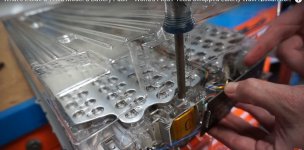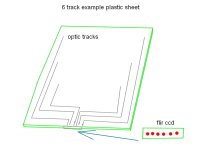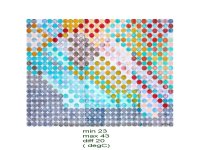whatever
100 kW
- Joined
- Jun 3, 2010
- Messages
- 1,297
just trying to think of some way to monitor a very large array of cells such as tesla pack for temperature.
Some simple way to identify if any cells temperature goes too high.
Came up with one idea that might work as follows.
Model S battery pack has a plastic cover ( clear ) over the cells as seen in photo below:

This plastic cover is directly over all the cells. All the cells emit radiation ( black body radiation) according to their temperature.
We are interested in the infrared region. This clear plastic sheet will have total internal reflection, so some of the radiation emitted will be reflected internally through ( along) the plastic. At the edge of the plastic you will be able to detect this radiation that flows through the plastic ( the internally reflected portion).
Lets say you insert an infrared sensor that picks up radiation of a temperature just below thermally damaging temperature of the cells.
I'm not sure what temp that is, lets say 75degC. or so.
Since the infrared sensor if sensitive enough should be able to detect radiation from any cell, there might be some preferred location for the sensor. Once the pack is closed there are covers in place that reduce the outside radiation entering the cells.
If the sensor detects a predetermined wavelength the pack can be isolated. It might take a few of these sensors to cover the whole pack, but the total internal reflection should mean only a few are required. Maybe one will be enough
Below is a pic to further explain the idea

Some simple way to identify if any cells temperature goes too high.
Came up with one idea that might work as follows.
Model S battery pack has a plastic cover ( clear ) over the cells as seen in photo below:

This plastic cover is directly over all the cells. All the cells emit radiation ( black body radiation) according to their temperature.
We are interested in the infrared region. This clear plastic sheet will have total internal reflection, so some of the radiation emitted will be reflected internally through ( along) the plastic. At the edge of the plastic you will be able to detect this radiation that flows through the plastic ( the internally reflected portion).
Lets say you insert an infrared sensor that picks up radiation of a temperature just below thermally damaging temperature of the cells.
I'm not sure what temp that is, lets say 75degC. or so.
Since the infrared sensor if sensitive enough should be able to detect radiation from any cell, there might be some preferred location for the sensor. Once the pack is closed there are covers in place that reduce the outside radiation entering the cells.
If the sensor detects a predetermined wavelength the pack can be isolated. It might take a few of these sensors to cover the whole pack, but the total internal reflection should mean only a few are required. Maybe one will be enough
Below is a pic to further explain the idea






